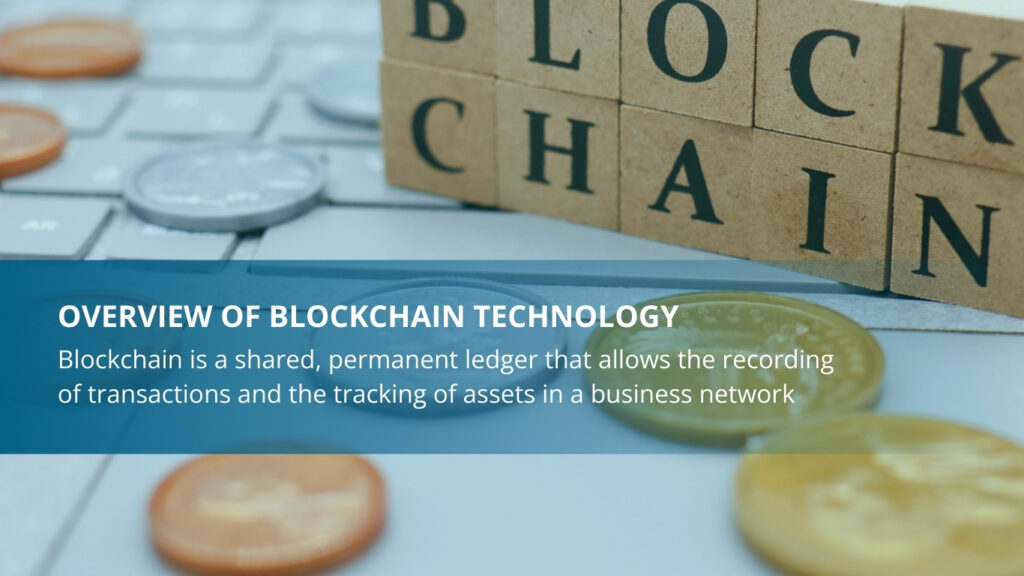An Overview of Blockchain Technology

Blockchain is a shared, permanent ledger that allows the recording of transactions and the tracking of assets in a business network. A capital asset, such as a home, vehicle, cash, or land, can also be intangible items like intellectual property, patents, copyrights and branding. A blockchain network can track and facilitate the exchange of any item that has value, reducing risk and costs for those involved.
The Blockchain Market – The worldwide blockchain technology market was worth USD 10.02 billion in 2022 and is predicted to increase at an annual compound growth rate (CAGR) of 87.7% between 2023 and 2030. Increased venture capital investment in blockchain technology businesses can be attributed to market growth. Circle Internet Finance Ltd., a blockchain technology company, revealed in May 2021 that it had raised USD 440 million in capital from strategic and institutional investors. This investment was utilised for organisational growth and market expansion by the firm.
Why is Blockchain important?
Information is the lifeblood of business, more specific and fast, the better. Blockchain is great for delivering such information because it delivers instantaneous, shareable, and entirely transparent data recorded on an immutable ledger that can only be viewed by network users with permission.

A blockchain network can monitor production, orders, payments, and accounts, among other things. Additionally, since members have a unified perspective of the truth, you can see all aspects of a transaction from start to finish, offering you greater confidence and new efficiencies and possibilities.
A blockchain’s essential components
The technology of distributed ledgers – The distributed ledger and its immutable record of transactions are accessible to all network members. With this shared ledger, transactions are recorded just once, avoiding the duplication of effort that is frequent in traditional commercial networks.

- Records that cannot be changed: When a transaction has been logged to the shared ledger, no participant may edit or tamper with it.
- If a mistake is found in a transaction record, a new transaction must be entered to correct the issue, and both transactions are then visible.
- Contracts that are smart: To speed up transactions, a set of rules known as a smart contract is published on the blockchain and automatically applied. A smart contract can establish the criteria for corporate bond transfers, travel insurance payments, and much more.
How does it work?
Once each transaction occurs, it is logged as a “block” of data. These transactions demonstrate the movement of an asset, which might be physical or intangible.
Each block is connected to the ones that come before and after it. If an asset transfer from one location to another or ownership changes hands, these blocks create a data chain. The blocks validate the precise timing and sequence of transactions, and they are securely linked together to prevent any block from being edited or added between two existing blocks.
A blockchain is an irreversible chain that connects transactions. Each subsequent block confirms the previous block’s verification, and so is the whole blockchain. As a result, the blockchain’s integrity is preserved, providing it with increased security.
Challenges of Blockchain
Inadequate Privacy: This means that blockchain technology will be unable to operate with sensitive data until the issue is resolved. Here, either private or federated blockchain can be used. You would have restricted access, and all of your sensitive information would be kept private, as it should be.
Lack of regulation: Here is where the problem arises. Although one of the benefits of blockchain is visibility, security can still be a concern. You won’t know for certain if it’s safe for you. Governments and highly regulated businesses may need to establish blockchain laws to tackle these challenges.
Security Issues: Having 51% of the nodes on the blockchain network gives those in control the ability to modify the data. This type of assaults is one of the network’s security flaws. Hackers or Miners can take control of the network and exploit it in these assaults. They can even change the transaction process and prevent others from adding blocks. To address this, the protocol layer requires increased security.
Insufficient skill sets: In addition to software and hardware, skilled staff must be found to administer blockchain technology. As you may be aware, blockchain technology is still in its early stages. Nowadays, few individuals are equipped to support such technologies. On the other side, there is a high need for competent personnel. Thus, employing qualified workers, are often on the higher side.
Conclusion
Many businesses are eager to deploy or use this technology, and they are spending heavily on it. As a result, it’s just a matter of time until we witness a significant shift in society and the economy. In actuality, many applications and projects are already online and fully functional. As you can see, every blockchain challenge will have remedies and possibilities. Blockchain has a bright future, and its potential to reshape businesses is only getting started. Blockchain’s secure, distributed nature can help businesses save costs, increase efficiency, and improve transparency. Businesses will be able to reap the benefits of technology as they get more familiar with it, allowing them to remain competitive in an ever-changing market. When it comes to using blockchain for commercial reasons, the possibilities are boundless; from smart contracts to improved supply chain management, there’s no knowing how far this revolutionary technology can lead us. If you are looking to take advantage of this new technology in your business you should consider outsourcing some processes with AccSource as an easy and cost-effective way to increase your productivity and reduce costs.
